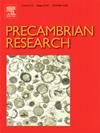冀东地区古太古代-中太古代岩浆岩新发现:岩石成因与构造环境
IF 3.2
2区 地球科学
Q2 GEOSCIENCES, MULTIDISCIPLINARY
引用次数: 0
摘要
本文报道了华北克拉通河北东部拉巴山地区近1 km范围内新发现的古太古代—中太古代岩浆岩的野外地质、SHRIMP U-Pb锆石定年、Nd-Hf-O同位素分析和全岩地球化学研究。ttg、钾质花岗岩和变质辉长岩岩浆锆石年龄可划分为3513 ~ 3381 Ma和3124 ~ 2960 Ma两组。因此,结合前人的研究,该区分别在4.0 ~ 3.9 Ga、3.84 ~ 3.75 Ga、约3.6 Ga、3.51 ~ 3.38 Ga、3.12 ~ 2.96 Ga和2.50 Ga发生过岩浆活动。TTG岩石包括调性片麻岩和长闪质片麻岩,稀土元素模式变化较大,ΣREE(总REE)、(La/Yb)n和Eu/Eu*分别为65.8 ~ 356.6 ppm、26.1 ~ 195.1和0.26 ~ 1.83。钾质花岗岩包括二长花岗质和正长花岗质片麻质,它们在ΣREE (59.4 ~ 238.5 ppm)、(La/Yb)n(17.81 ~ 106.14)和Eu/Eu*(0.25 ~ 1.11)方面也有较大的变化。变质辉长岩和绿泥岩-黑云母-角闪石片岩(变质基性岩)的稀土元素分布模式相似,ΣREE、(La/Yb)n和Eu/Eu*分别为34.0 ~ 50.8 ppm、1.80 ~ 3.83和0.87 ~ 0.96。多数岩石具有负的全岩εNd(t)和锆石εNd(t)值,Nd和Hf模式年龄一般为>;3.6 Ga。TTG和变辉长岩的岩浆锆石和再结晶锆石的δ18O值分别为4.69 ~ 7.03‰和4.67 ~ 6.17‰,钾质花岗岩的δ18O值变化较大,为3.15 ~ 9.36‰。岩浆岩的化学组成和同位素组成差异较大,表明其形成于不同源区、不同条件下,其中TTG岩形成于中低压条件下,部分钾质花岗岩形成于变质沉积岩或与变质沉积岩有关。认为古太古代和中太古代岩浆-构造-热事件都是通过古地壳的下镀发生的。本文章由计算机程序翻译,如有差异,请以英文原文为准。
New discovery of Paleoarchean-Mesoarchean magmatic rocks in eastern Hebei, North China Craton: Petrogenesis and tectonic environment
We report the field geology, SHRIMP U-Pb zircon dating, Nd-Hf-O isotopic analysis, and whole-rock geochemical study of Paleoarchean-Mesoarchean magmatic rocks newly discovered over a distance of ∼1 km in the Labashan area, eastern Hebei, North China Craton. The ages obtained for the magmatic zircons from TTGs, potassic granites and meta-gabbros can be divided into two groups: 3513–3381 Ma and 3124–2960 Ma. Thus, combined with previous studies, several periods of magmatism have been documented at 4.0–3.9 Ga, 3.84–3.75 Ga, ca. 3.6 Ga, 3.51–3.38 Ga, 3.12–2.96 Ga and 2.50 Ga in the area. The TTG rocks include tonalitic and trondhjemitic gneisses, showing large variations in REE patterns, with ΣREE (total REE), (La/Yb)n and Eu/Eu* being 65.8–356.6 ppm, 26.1–195.1 and 0.26–1.83, respectively. The potassic granites include monzogranitic and syenogranitic gneisses, they also show large variations in ΣREE (59.4–238.5 ppm), (La/Yb)n (17.81–106.14) and Eu/Eu* (0.25–1.11). The meta-gabbros and chlorite-biotite-hornblende schists (meta-mafic rocks) have similar REE patterns, with ΣREE, (La/Yb)n and Eu/Eu* being 34.0–50.8 ppm, 1.80–3.83 and 0.87–0.96, respectively. Most rocks have negative whole-rock εNd(t) and zircon εNd(t) values, with Nd and Hf model ages commonly being > 3.6 Ga. Magmatic and recrystallized zircons from TTG and meta-gabbro have δ18O values of 4.69–7.03 ‰ and 4.67–6.17 ‰, respectively, whereas those from potassic granite show larger δ18O variations from 3.15 to 9.36 ‰. The magmatic rocks show large variations in chemical and isotopic compositions, suggesting that they are derived from different source regions under different conditions, with TTG rocks being formed under medium–low pressure conditions and some potassic granites being derived from or involved with meta-sedimentary rocks in their petrogenesis. It is proposed that both the Paleoarchean and Mesoarchean magma-tectonothermal events occurred via underplating of older crust.
求助全文
通过发布文献求助,成功后即可免费获取论文全文。
去求助
来源期刊

Precambrian Research
地学-地球科学综合
CiteScore
7.20
自引率
28.90%
发文量
325
审稿时长
12 months
期刊介绍:
Precambrian Research publishes studies on all aspects of the early stages of the composition, structure and evolution of the Earth and its planetary neighbours. With a focus on process-oriented and comparative studies, it covers, but is not restricted to, subjects such as:
(1) Chemical, biological, biochemical and cosmochemical evolution; the origin of life; the evolution of the oceans and atmosphere; the early fossil record; palaeobiology;
(2) Geochronology and isotope and elemental geochemistry;
(3) Precambrian mineral deposits;
(4) Geophysical aspects of the early Earth and Precambrian terrains;
(5) Nature, formation and evolution of the Precambrian lithosphere and mantle including magmatic, depositional, metamorphic and tectonic processes.
In addition, the editors particularly welcome integrated process-oriented studies that involve a combination of the above fields and comparative studies that demonstrate the effect of Precambrian evolution on Phanerozoic earth system processes.
Regional and localised studies of Precambrian phenomena are considered appropriate only when the detail and quality allow illustration of a wider process, or when significant gaps in basic knowledge of a particular area can be filled.
 求助内容:
求助内容: 应助结果提醒方式:
应助结果提醒方式:


